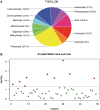METAGENassist: a comprehensive web server for comparative metagenomics
- PMID: 22645318
- PMCID: PMC3394294
- DOI: 10.1093/nar/gks497
METAGENassist: a comprehensive web server for comparative metagenomics
Abstract
With recent improvements in DNA sequencing and sample extraction techniques, the quantity and quality of metagenomic data are now growing exponentially. This abundance of richly annotated metagenomic data and bacterial census information has spawned a new branch of microbiology called comparative metagenomics. Comparative metagenomics involves the comparison of bacterial populations between different environmental samples, different culture conditions or different microbial hosts. However, in order to do comparative metagenomics, one typically requires a sophisticated knowledge of multivariate statistics and/or advanced software programming skills. To make comparative metagenomics more accessible to microbiologists, we have developed a freely accessible, easy-to-use web server for comparative metagenomic analysis called METAGENassist. Users can upload their bacterial census data from a wide variety of common formats, using either amplified 16S rRNA data or shotgun metagenomic data. Metadata concerning environmental, culture, or host conditions can also be uploaded. During the data upload process, METAGENassist also performs an automated taxonomic-to-phenotypic mapping. Phenotypic information covering nearly 20 functional categories such as GC content, genome size, oxygen requirements, energy sources and preferred temperature range is automatically generated from the taxonomic input data. Using this phenotypically enriched data, users can then perform a variety of multivariate and univariate data analyses including fold change analysis, t-tests, PCA, PLS-DA, clustering and classification. To facilitate data processing, users are guided through a step-by-step analysis workflow using a variety of menus, information hyperlinks and check boxes. METAGENassist also generates colorful, publication quality tables and graphs that can be downloaded and used directly in the preparation of scientific papers. METAGENassist is available at http://www.metagenassist.ca.
Figures


References
-
- Metzker ML. Sequencing technologies—the next generation. Nat. Rev. Genet. 2010;11:31–46. - PubMed
-
- Turnbaugh PJ, Ley RE, Mahowald MA, Magrini V, Mardis ER, Gordon JI. An obesity-associated gut microbiome with increased capacity for energy harvest. Nature. 2006;444:1027–1031. - PubMed
-
- Yooseph S, Nealson KH, Rusch DB, McCrow JP, Dupont CL, Kim M, Johnson J, Montgomery R, Ferriera S, Beeson K, et al. Genomic and functional adaptation in surface ocean planktonic prokaryotes. Nature. 2010;468:60–66. - PubMed
-
- Schloss PD, Westcott SL, Ryabin T, Hall JR, Hartmann M, Hollister EB, Lesniewski RA, Oakley BB, Parks DH, Robinson CJ, et al. Introducing mothur: open-source, platform-independent, community-supported software for describing and comparing microbial communities. Appl. Environ. Microbiol. 2009;75:7537–7541. - PMC - PubMed
Publication types
MeSH terms
Grants and funding
LinkOut - more resources
Full Text Sources
Other Literature Sources
Miscellaneous

